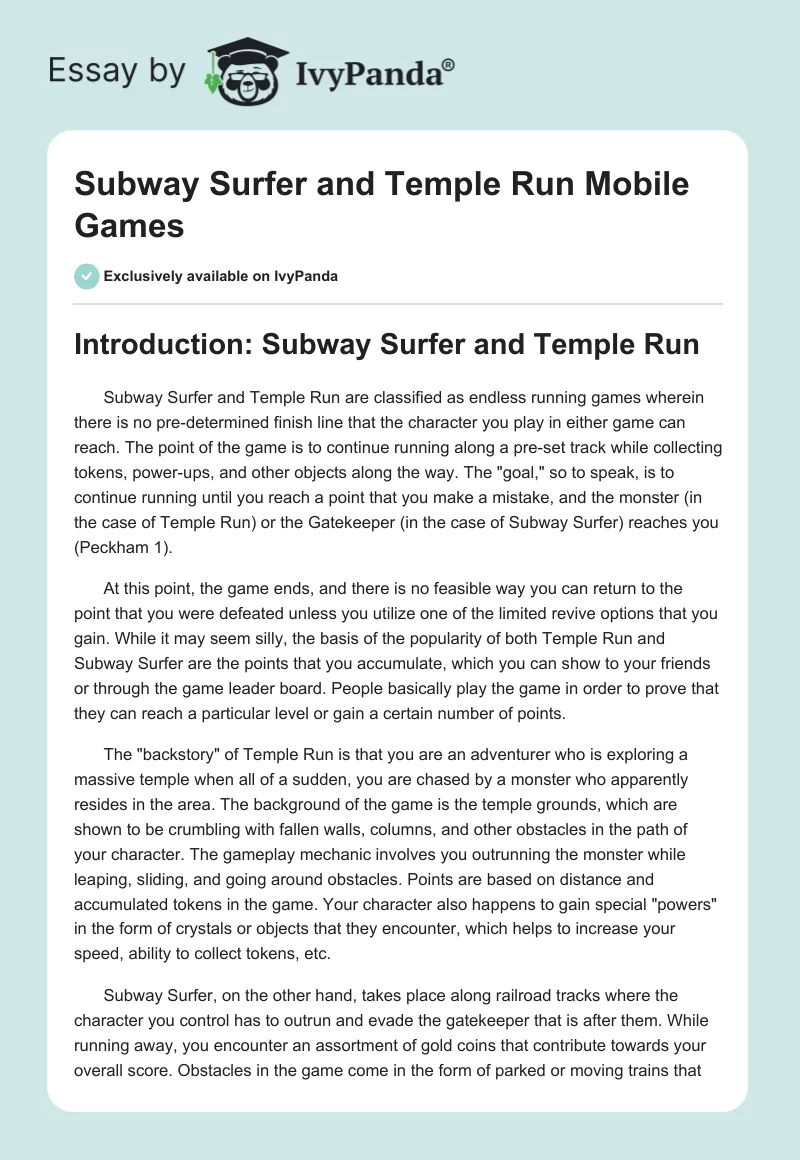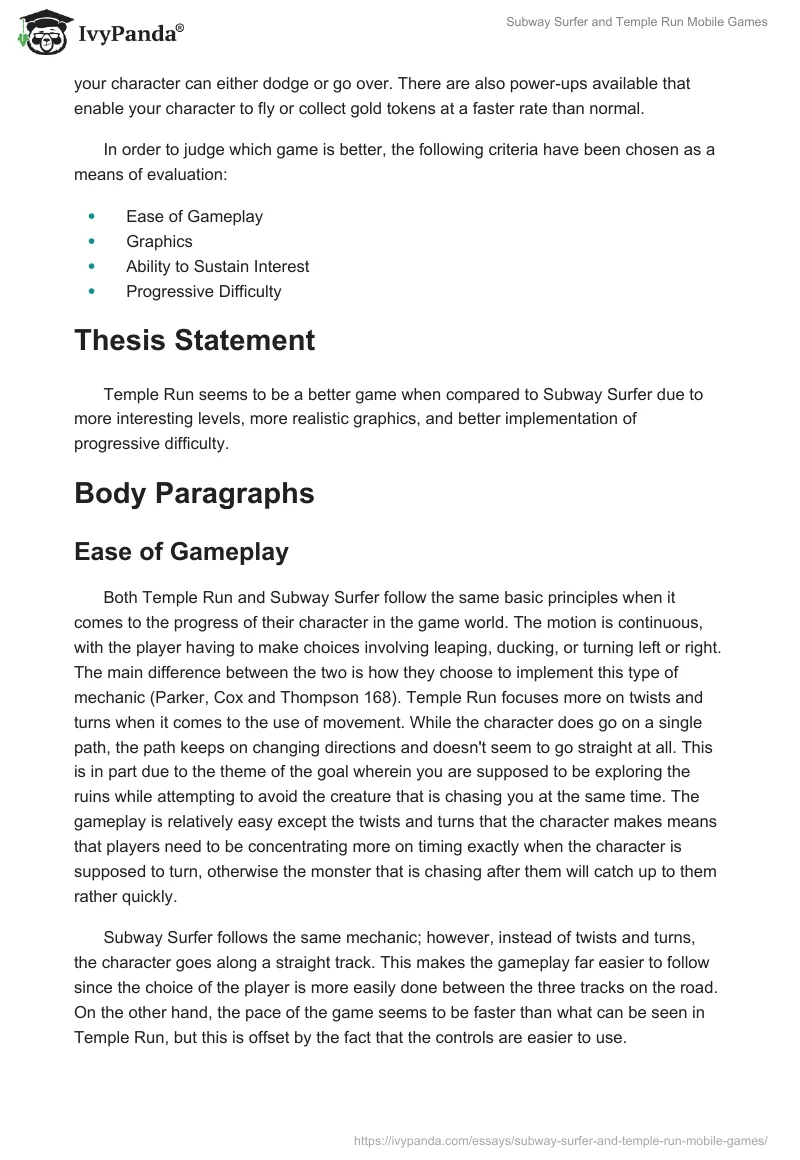Introduction: Subway Surfer and Temple Run
Subway Surfer and Temple Run are classified as endless running games wherein there is no pre-determined finish line that the character you play in either game can reach. The point of the game is to continue running along a pre-set track while collecting tokens, power-ups, and other objects along the way. The “goal,” so to speak, is to continue running until you reach a point that you make a mistake, and the monster (in the case of Temple Run) or the Gatekeeper (in the case of Subway Surfer) reaches you (Peckham 1).
At this point, the game ends, and there is no feasible way you can return to the point that you were defeated unless you utilize one of the limited revive options that you gain. While it may seem silly, the basis of the popularity of both Temple Run and Subway Surfer are the points that you accumulate, which you can show to your friends or through the game leader board. People basically play the game in order to prove that they can reach a particular level or gain a certain number of points.
The “backstory” of Temple Run is that you are an adventurer who is exploring a massive temple when all of a sudden, you are chased by a monster who apparently resides in the area. The background of the game is the temple grounds, which are shown to be crumbling with fallen walls, columns, and other obstacles in the path of your character. The gameplay mechanic involves you outrunning the monster while leaping, sliding, and going around obstacles. Points are based on distance and accumulated tokens in the game. Your character also happens to gain special “powers” in the form of crystals or objects that they encounter, which helps to increase your speed, ability to collect tokens, etc.
Subway Surfer, on the other hand, takes place along railroad tracks where the character you control has to outrun and evade the gatekeeper that is after them. While running away, you encounter an assortment of gold coins that contribute towards your overall score. Obstacles in the game come in the form of parked or moving trains that your character can either dodge or go over. There are also power-ups available that enable your character to fly or collect gold tokens at a faster rate than normal.
In order to judge which game is better, the following criteria have been chosen as a means of evaluation:
- Ease of Gameplay
- Graphics
- Ability to Sustain Interest
- Progressive Difficulty
Thesis Statement
Temple Run seems to be a better game when compared to Subway Surfer due to more interesting levels, more realistic graphics, and better implementation of progressive difficulty.
Body Paragraphs
Ease of Gameplay
Both Temple Run and Subway Surfer follow the same basic principles when it comes to the progress of their character in the game world. The motion is continuous, with the player having to make choices involving leaping, ducking, or turning left or right. The main difference between the two is how they choose to implement this type of mechanic (Parker, Cox and Thompson 168). Temple Run focuses more on twists and turns when it comes to the use of movement. While the character does go on a single path, the path keeps on changing directions and doesn’t seem to go straight at all. This is in part due to the theme of the goal wherein you are supposed to be exploring the ruins while attempting to avoid the creature that is chasing you at the same time. The gameplay is relatively easy except the twists and turns that the character makes means that players need to be concentrating more on timing exactly when the character is supposed to turn, otherwise the monster that is chasing after them will catch up to them rather quickly.
Subway Surfer follows the same mechanic; however, instead of twists and turns, the character goes along a straight track. This makes the gameplay far easier to follow since the choice of the player is more easily done between the three tracks on the road. On the other hand, the pace of the game seems to be faster than what can be seen in Temple Run, but this is offset by the fact that the controls are easier to use.
Graphics
Both games have widely divergent graphics by virtue of the theme that they follow. Temple Run follows a more realistic style of level depiction where the game developers attempted to really showcase how a crumbling temple with deteriorating walls would look like (Chehimi, Fadi, and Edwards 21). Subway Surfer, on the other hand, is more cartoonish with brighter colors and a focus towards making the game look smoother and more “game-like” as compared to the more realistic depiction show in Temple Run. Choosing between the two games will depend entirely on personal preference, where a person would have to choose between something that is aesthetically pleasing but more cartoonish or something that is more realistic yet has a darker overall appearance.
Ability to Sustain Interest
The ability of a game to sustain interest is connected to how interesting the progression of your character is as it gains more points (Konrad 10). This criteria is based on how the game makes people want to play it beyond the original goal of gaining more points to get ahead of your friends and make it to the top of the leader board (Johanek 8). The game play in Temple Run focus on evasion, getting more tokens and acquiring powers in order to make the game easier. As you progress, you gain access to more unique levels in the temple that showcase a wide variety of different traps, paths and generally interesting mechanics that makes continuous play a unique experience.
Subway Surfer does have the same aspects related to evasion, tokens, etc. but the way the game works is you basically dodge or go over trains. While there is a power to fly over the train tracks, this is rarely seen and in most cases the character has to just keep on running. Over time, the game play mechanics and background tend to be repetitive with the goal of acquiring more golden tokens taking precedence over being amused with the new types of obstacles that are implemented.
Progressive Difficulty
The concept behind progressive difficulty in a game is based on how much more effort players have to put into avoiding the traps and obstacles that they encounter (Munson 20). Progressive difficulty thus acts as a means of ensuring that players are not bored with the game and feel sufficiently challenged the more they explore. In the case of Temple Run, the more players progress, the harder the levels get with more challenges involving dodging and using powers properly in order to get around particular issues or to speed up the game play. The same can be said for the experience when playing Subway Surfer; however, the difficulty actually tapers off after a while and the game play just seems to be the same. While Temple Run also has this particular flaw, it makes up for it by inter-spacing the running mechanic with more elaborate sequences that require you to really pay attention. Subway Surfer seems to be less attention oriented and more focused on letting people enjoy a casual gaming experience.
Conclusion
Based on the analysis that has been conducted, this paper concludes that Temple Run seems to be a better game when compared to Subway Surfer due to more interesting levels, more realistic graphics and better implementation of progressive difficulty. While it may be true that Subway Surfer has better looking graphics, it seems to be far too cartoonish and seems to be more repetitive rather than original.
What can be taken from the findings of this paper is that despite two games sharing the same game mechanic, it cannot be stated that they would elicit the same type of reaction from consumers. This also brings up the notion that the findings of this paper are subject to personal bias since other reviewers may prefer a game whose graphics are more cartoonish rather than one that is more realistic. Overall, this paper is more of a reflection of personal opinion based on the requirements of the topic rather than an objective analysis based on factual evidence that does not require personal opinions.
Works Cited
Chehimi, Fadi, Paul Coulton, and Reuben Edwards. “Evolution Of 3D Mobile Games Development.” Personal & Ubiquitous Computing 12.1 (2008): 19-25. Print
Johanek, Marilou. “OPINION: Computer-savvy youths fall prey to app makers.” Blade, The (OH) 25 Jan. 2014: 8. Print
Konrad, Alex. “As Millions Play ‘Temple Run 2,’ Its Husband And Wife Team Prefers To Stay Small.” Forbes (2013): 10. Print
Munson, Ben. “Monetizing Mobile Proves Serious Business.” Wireless Week 20.1 (2013): 20. Print
Parker, Rachel, Stephen Cox, and Paul Thompson. “How Technological Change Affects Power Relations In Global Markets: Remote Developers In The Console And Mobile Games Industry.” Environment & Planning A 46.1 (2014): 168-185. Print
Peckham, Matt. “Temple Run Scampers Past One Billion Downloads.” Time (2014): 1. Print


